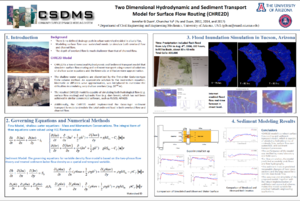2018 CSDMS meeting-044
Log in (or create account for non-CSDMS members)
Forgot username? Search or email:CSDMSweb@colorado.edu
Browse abstracts
Impact of Climate Change on Flood Frequency Curve: Santa Cruz River Case Study

Hourly precipitation for one historical (1991-2000) and two future periods (2031-2040 and 2071-2079) were generated using the Weather Research and Forecasting (WRF) Regional Climate Model (RCM). The climate simulations were conducted for the Southwest region of the United States using an hourly temporal and 10 km spatial resolution grid. The boundary forcing for the WRF model was developed by the Hadley Centre for Climate Prediction and Research/Met Office’s HadCM3 model with A2 emission scenario. The precipitation from the RCM-WRF model was bias-corrected using the observed data, and then used to quantify the impact of climate change on the magnitude and frequency of flood flow in the upper Santa Cruz River watershed (USCRW) in southern Arizona. The Computational Hydraulics and River Engineering two-dimensional (CHRE2D) model, a two-dimensional hydrodynamic and sediment transport model, was adapted for surface flow routing. The CHRE2D model was first calibrated using a storm event on July 15th, 1999, and then applied to the watershed for three selected periods. The simulated annual maximum discharges in two future periods were added to the historical records to obtain the flood frequency curve. Results indicate the peak discharges of 100-year, 200-year, and 500-year flood only increased slightly, and the increase is within the 90% confidence interval limits. Therefore, the flood magnitude and frequency curve will not change with the inclusion of projected future climate data for the study watershed.
